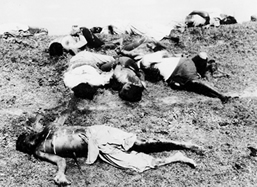
Narayanganj district (Dhaka division) with an area of 759.57 sq km, is bounded by Gazipur and Narsingdi districts on the north, Brahmanbaria and Comilla districts on the east, Munshiganj district on the south, and Dhaka district on the west. Geologically, the area lies on the edge of the Madhupur tract and the Holocene floodplain deposits form the aquifer. The total area of the district is 759.57 sq km., of which 48.56 sq km. is reverine and 0.60 sq km. is under forest. The district lies between 23°33´and 23°57´north latitude and between 90°26´ and 90°45´ east longitude. Average maximum temperature 36°C, minimum 12.7°C; annual total rainfall 2376 mm. Physically the zila is characterised by alluvial formations caused by several rivers such as, Shitalakshya, Meghna, Old Brahmaputra, Buriganga, Balu and Dhaleshwari.
Narayanganj a former sub-divisional town of dhaka district upgraded to a district headquarter in February 1984. Narayanganj, the oldest and the most prominent river port of Bangladesh, grew into a place of trade and commerce and therefore, became known as a ganj. Vicon Lal Pandey (also known as Benur Thakur or Lakhsmi Narayan Thakur), a Hindu religious leader, acquired the ownership of this region from the East India Company in 1766. He declared the markets located on the bank of the river Shitalakshya as endowed property by a will to meet the expenses of the worship of Narayan and consequently, the place got the name Narayanganj.
Narayanganj subdivision was established in 1882 and was turned into a district in 1984. The district consists of five upazilas, 49 union parishads, 881 mouzas, 1374 villages, 2 municipalities, 12 wards and 115 mahallas. The upazilas are Araihazar, Bandar, Narayanganj sadar, Rupganj, and Sonargaon.
Narayanganj (Town) a municipal town (estd. in 1876), consists of 8 wards and 76 mahallas. The area of the town is 18.7 sq km. It has a population of 230294; male 53.51%, female 46.49%. The density of population is 12315 per sq km. The literacy rate among the town people 60.2%.
Narayanganj is connected to Dhaka by three metalled roads and a metre gauge rail line as well as by waterways through the rivers Buriganga and Shitalakshya. Steamer services from Narayanganj started in 1862. At that time, steamer and rail routes via Goalanda and Narayanganj connected Dhaka with calcutta. Narayanganj was then known more as the port of Dhaka. Narayanganj grew in importance after the arrival of the Portuguese and the English traders during the early parts of the 17th and 18th centuries respectively. Though the west bank of Shitalakshya was an important commercial centre since the rule of Mir Jumla in the early years of the second half of the 17th century. One of the important places of Narayanganj is Sonargaon, which had the distinction of being described by Ralph Fitch in 1583 as the place "where there is the best and finest cloth made of cotton that is in all India". Sonargaon is historically famous for manufacturing a species of very fine muslin. Narayanganj at times was known as the 'Dandy of the East.' National warehouse (silo-type), largest jute mill, cotton mills and a number of industrial units are located at Narayanganj. A major establishment of the Bangladesh Engineering and Ship Building Corporation established in 1925 at Sonakanda.
Archaeological heritage: Tomb of Sultan Giasuddin Azam Shah (1389-1411 AD), Baba Saleh Mosque (1481 AD), Goaldi Mosque (1519 AD), three domed mosque of Sultan Jalaluddin Fateh Shah (1484 AD), Hajiganj Fort, Sunakanda Fort, Pagla Bridge, Kadam Rasul Dargah, Bandar Shahi Mosque.
Historical events: Sonargaon of the district was an important historical place from the ancient time. It was the capital of Bengal during the reign of Isa khan.(see Sonargaon upazila HQ)
As of the 1991 Bangladesh census, Population 2138492; male 52.60% and female 47.40%; Muslim 92.59%, Hindu 6.43%, others 1.07%.
Religious institutions: Mosque 2006, temple 82, church 4, sacred place 4 and monastery 1.
Literacy rate and educational institutions: Average literacy 39.84%; male 46.23% and female 32.24%. Educational institutions: art college 1, physical education institute 1, marine technology centre 1. government. high school 2, non-government high school 127, madrasa 76, government. primary school 376, non-government primary school 47, kindergarten school 12, satellite school 24, community school 65, NGO operated school 285. The noted educational institutions are Narayanganj High School (1885), Tolaram College (1937) and Sonargaon J R institute (1900).
Cultural organisations Club 125, museum 1, public library 15, theatre group 15, literacy organisation 12, theatre spot 2, cinema hall 32, dakbungalow 6, shilpakala academy 1, shishu academy 1, community centre 8, Islamic foundation 1, mohila sangstha 2. Most reputed cultural institutions are the Folk Arts and Crafts Foundation at Sonargaon and Narayanganj Rifle Club.
Main occupations Agriculture 13.37%, agricultural labourer 8.61%, wage labourer 4.07%, commerce 19.9%, service 23.36%, weaving 5.49%, transport 4.09%, fishing 1.21%, industries 2.74%, construction 1.48%, others 15.68%.
Main crops Paddy, jute, wheat, mustard seed, vegetables
Fisheries, poultries and dairies Dairy 636, poultry 860, hatchery 4, nursery 31.
Communication facilities Roads: pucca 225.98 km, mud road 748 km; railway 18 km; waterways 111 nautical mile.
Manufactories: Adamjee Jute Mills (closed in 2002), Chittaranjan Cotton Mills, Lakshmi Narayan Cotton Mills, Dhakeshwari Mills, Star Particle Board Mills, Dhaka Vegetable Oil Mills, Husain Paper Mills, Moula Textile, RM Steel Mill, Haripur Electricity Centre, Hosiery Industries, Dying Mill, Aluminum Factory. Besides, Kachpur has become as an industrial town.
Cottage industries: Weaving is traditionally the most important cottage industry. Rupashi and Kazipara are famous for Jamdani sari production. Narayanganj is also famous for hosiery products.
Main exports: Fruits and fruit products, jute and jute products, jamdani saris and hosiery products.
NGO activities: brac, grameen bank, asa, proshika, SIDA.
Health centres: Hospital 4, upazila health complex 7, family welfare centre 34, union health centre 19, satellite health centre 4, clinic 12.
Nearby cities: Dhaka City, Comilla District Town, Agartala
Coordinates: 23°37'23"N 90°30'25"E
















